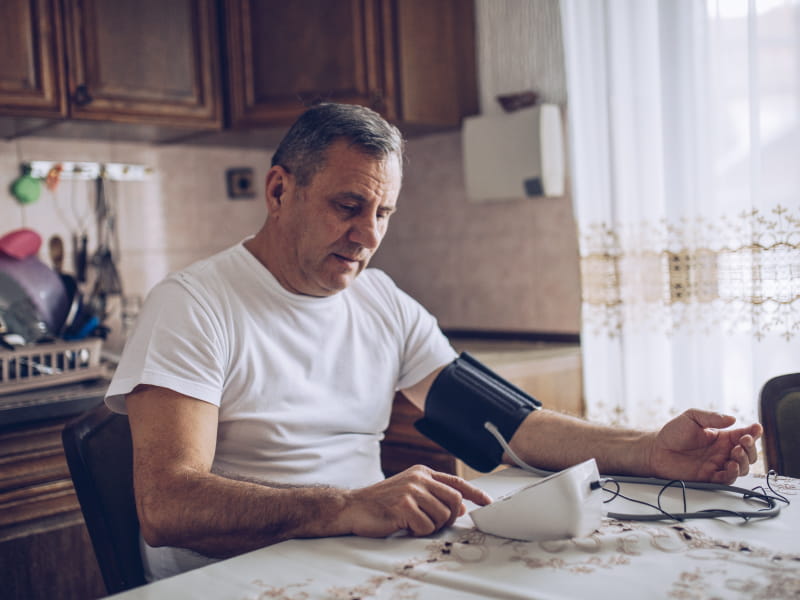How to accurately measure blood pressure at home
By American Heart Association News

High blood pressure is one of the top risk factors for heart attack and stroke. It's also common among people who develop severe COVID-19 symptoms.
So, with more people at home practicing social distancing and with fewer chances to check blood pressure at public pharmacy machines or doctor visits, it's more important than ever to know how to do it at home.
How do I select a home blood pressure monitor?
"The readings you get at home are really important, because they reflect the pressure your heart is facing on a day-to-day basis," said Dr. Michael Hochman, a doctor of internal medicine at Keck Medicine of the University of Southern California.
A list of validated home monitors, the first in the United States and commissioned to meet the American Medical Association's criteria, is available at validateBP.org. The Advancement of Medical Instrumentation, the British Hypertension Society and the European Society of Hypertension also certify devices.
The device should measure blood pressure on the upper arm, which produce a more reliable result than those that measure from the wrist.
Many devices are automated. Simply put on the cuff and press a button. The results are displayed digitally.
Some will store readings, calculate an average blood pressure over time, or even transmit them to your doctor.
"When blood pressure monitors cannot transmit readings to a patient's doctor, the next best thing is to have a device that stores the blood pressure readings," said Paul Muntner, professor of epidemiology and associate dean for research at the University of Alabama at Birmingham.
Your health care provider should check the device about once a year to ensure its accuracy.
How do I get the most accurate measurement?
Do not smoke, drink caffeinated beverages or exercise within 30 minutes before measuring your blood pressure. It's important to use a cuff that fits your arm. Cuffs that are too small can artificially raise your blood pressure reading.
With the cuff on your bare arm, sit in an upright position with back supported, feet flat on the floor and your arm supported at heart level. Make sure the bottom of the cuff is directly above the bend of the elbow. Relax for about five minutes before taking a measurement. Resist the urge to talk or look at a cellphone.
Also, make sure your bladder is empty, as a full one can temporarily raise blood pressure.
Some medications, including over-the-counter pain relievers called NSAIDs and common decongestants, can elevate blood pressure. Alcohol, caffeine, smoking, salt intake and stress can, too.
Muntner recommended people check their blood pressure at the same time each day, such as twice in the morning and twice in the evening for one week, then talk with their doctor about the results.
"Blood pressure fluctuates a lot, so a patient shouldn't worry about one high reading," Muntner said. "If the average over a full week is high, there's reason for people to talk to their doctors. If not, people should continue practicing heart-healthy behaviors and check their BP in the future."

What is the ideal blood pressure?
The device will give you a systolic number (upper) – the pressure against your artery walls when your heart beats – and a diastolic number (lower) – the pressure between beats.
For normal readings of less than 120/80, Muntner said it's not necessary to check blood pressure again for at least six months.
If the top number is 130 or greater, or the bottom number is 80 or greater, Muntner recommended talking with your doctor about your overall risk for heart attack and stroke.
"If someone is at higher risk – for example, they smoke or have diabetes – then they should be started on blood pressure-lowering medication," he said.
"If it's very high, 180 or higher (over) 110 or higher, you should call your doctor right away. The longer your blood pressure is high, the more you are at risk for heart attack and stroke."
There are many ways to lower blood pressure, including medication, getting more exercise, eating plenty of fruits and vegetables, not smoking, reducing salt and alcohol consumption, lowering stress and losing weight.
"For some people, it may be easier to reduce the amount of salt they eat. For others, it may be easier to do a little physical activity," Muntner said. "The important thing is to do the things that work for each individual."
If you have questions or comments about this story, please email [email protected].





